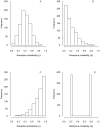Revisiting the effect of capture heterogeneity on survival estimates in capture-mark-recapture studies: does it matter?
- PMID: 23646131
- PMCID: PMC3639964
- DOI: 10.1371/journal.pone.0062636
Revisiting the effect of capture heterogeneity on survival estimates in capture-mark-recapture studies: does it matter?
Abstract
Recently developed capture-mark-recapture methods allow us to account for capture heterogeneity among individuals in the form of discrete mixtures and continuous individual random effects. In this article, we used simulations and two case studies to evaluate the effectiveness of continuously distributed individual random effects at removing potential bias due to capture heterogeneity, and to evaluate in what situation the added complexity of these models is justified. Simulations and case studies showed that ignoring individual capture heterogeneity generally led to a small negative bias in survival estimates and that individual random effects effectively removed this bias. As expected, accounting for capture heterogeneity also led to slightly less precise survival estimates. Our case studies also showed that accounting for capture heterogeneity increased in importance towards the end of study. Though ignoring capture heterogeneity led to a small bias in survival estimates, such bias may greatly impact management decisions. We advocate reducing potential heterogeneity at the sampling design stage. Where this is insufficient, we recommend modelling individual capture heterogeneity in situations such as when a large proportion of the individuals has a low detection probability (e.g. in the presence of floaters) and situations where the most recent survival estimates are of great interest (e.g. in applied conservation).
Conflict of interest statement
Figures




References
-
- Stearns SC (1992) The evolution of life histories. Oxford: Oxford University Press.
-
- Roulin A, Altwegg R, Jensen H, Steinsland I, Schaub M (2010) Sex-dependent selection on an autosomal melanic female ornament promotes the evolution of sex ratio bias. Ecology Letters 13: 616–626. - PubMed
-
- Morris WF, Doak DF (2002) Quantitative conservation biology. Sunderland, MA: Sinauer Associates Inc.
-
- Lebreton J-D, Burnham KP, Clobert J, Anderson DR (1992) Modelling survival and testing biological hypotheses using marked animals: a unified approach with case studies. Ecological Monographs 62: 67–118.
-
- Sandercock BK (2006) Estimation of demographic parameters from live-encounter data: a summary review. Journal of Wildlife Management 70: 1504–1520.
Publication types
MeSH terms
LinkOut - more resources
Full Text Sources
Other Literature Sources
Research Materials

